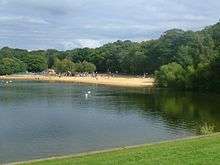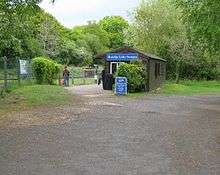Ruislip Lido

Ruislip Lido (/ˈraɪslɪp ˈlaɪdoʊ/ RY-slip LY-doh) is a reservoir and artificial beach in Ruislip, within the London Borough of Hillingdon, England, situated between Ruislip Common, Ruislip Woods (a Site of Special Scientific Interest),[1] and Poors Field.
Originally opened as a feeder reservoir for the Grand Junction Canal in 1811, the reservoir was reopened in 1933 as a lido, with facilities for swimming and boating. A narrow gauge railway, the Ruislip Lido Railway was opened in 1945, and now runs about two thirds of the distance around the reservoir.[2]
Having fallen into a state of disrepair during the 1970s and 1980s, the lido has since undergone renewal works, and was the subject of an enhancement project unveiled by the London Borough of Hillingdon in January 2010. The project involved the return of boating and swimming in the reservoir, which had previously not been possible due to pollution and an artificially low water level.
History
Construction

The Grand Junction Canal Company purchased 61.5 acres (24.9 ha) of Park Wood from Kings College, Cambridge, 56 acres (23 ha) of land from the commissioners and 35 acres (14 ha) of the cottages and gardens of the hamlet of Park Hearne. The valley that the land covered was then dammed and flooded.[3]
The reservoir was opened on 5 December 1811 as one of the feeder reservoirs for the Grand Junction Canal by engineer John Rennie and constructor Hugh Mackintosh.[4] The link to the canal did not fulfil its intended purpose, since the water became polluted by the land and was eventually stopped as a feeder in 1851.
The canal (now renamed the Grand Union Canal) is located some distance to the west and a culvert was built to lead water to the canal at Hayes Bridge which is seven miles from the Lido. Some of the route was underground and parts have been built over.[5] Part of the route includes a little-known aqueduct which carries the canal feeder over the River Pinn near Woodville Gardens.[6]
Lido opening

The reservoir was developed as a lido in 1933, with an Art Deco style main building designed by George W. Smith, together with an area reserved for swimming. The formal opening was by Earl Howe in 1936. The building included a cafe and changing rooms, and featured a terrace with steps leading into the enclosed swimming pool. The pool was built with a concrete base, and jetties on either side, but was open into the lido.[7]
Rowing boats were available for hire, with boathouses on the western side of the reservoir. An enclosed boating area for children was later constructed. The reservoir became a popular location for water-skiing, and televised championships were often held there.[7] One of the Ruislip Water Ski Club's founding members was the former Doctor Who actor Jon Pertwee.[8]
Ruislip Sailing Club was based at the lido, using the Graduate and Solo dinghy types. In the 1970s, the reservoir water level was artificially lowered to prevent the flooding of nearby housing, making it unsuitable for dinghy sailing.[9]
Several films were made there, including The Young Ones with Cliff Richard and A Night to Remember, where the large model of the RMS Titanic "sank on film".[7]
Ruislip Lido Railway
The railway was opened in 1945 with short trains being hauled by Prince Edward, an Atlantic-type steam locomotive. The line was less than a third of what it is today, as it was just a dog bone circuit on the south-east shore of the lido, running around the woods. It was built by the Grand Union Canal Company as part of the Lido along with a beach on the south-east shore.
The Ruislip Lido Railway (miniature railway) is still running today, manned by volunteers, and has been lengthened considerably, a second station and platform having been added near the Water's Edge pub.
Decline and future development

It is said that the local council ran the lido into financial ruin in the 1970s by raising the admission fee beyond the level the market would stand.[10][11] Additionally, the main Art Deco building was closed and became subject to vandalism. In June 1993, it was damaged beyond repair in an arson attack and was demolished in 1994.[12] The building was replaced in 1996 by a restaurant named The Water's Edge, built in a similar style.[7]
The lido remains a popular location for sunbathing and beach games, and although swimming is officially not allowed owing to pollution and lack of lifeguards, people do swim there.[13] A splash pad water play area for children was built in 2009.[14] Throughout the summer of 2011, the splash pad was closed after the electrics were damaged beyond repair during construction of a new toilet block.[15]
In January 2010, Hillingdon Council unveiled an enhancement project for the lido, including reinstating the outdoor swimming area and establishing special boating areas.[16] During recent testing, the water proved to be of an acceptable standard for inland bathing as set down by EC directive 76/160/EEC. It is proposed that the new swimming areas will be buoyed off.
The establishment of boating areas would require the water level to be raised, which the Environment Agency raised concerns over due to the potential for the flooding of nearby homes.[17] The water level had been kept artificially low since 1992 when floods caused damage to newly built houses close by.[18] The engineering consultancy firm Halcrow Group presented a report to Hillingdon Council in April 2010 recommending a £250,000 flood mitigation scheme.[19]
In January 2012, the plans received the necessary safety approvals from the Environment Agency in order to proceed.[20]
References
- Citations
- ↑ Natural England
- ↑ "Ruislip Lido Railway". Ruislip Lido Railway Society. 2010. Retrieved 19 April 2011.
- ↑ Bowlt 1994, p.125
- ↑ Bowlt 1994, p.127
- ↑ The Ruislip Lido Canal Feeder, Part One, Ruislip
- ↑ Ruislip's secret aqueduct
- 1 2 3 4 Bowlt 2007, p.29
- ↑ Newbery et al 1996, p.54
- ↑ Bowlt 2007, p.28
- ↑ Demise of the Lido (scroll down)
- ↑ The story of Ruislip Common Water Pumping Station and its Curious Aftermath (with footnote by the son of the engineer, Mr. Hester)
- ↑ Newbery et al 1996, p.53
- ↑ Ruislip Lido
- ↑ "New water feature to make a splash". London Borough of Hillingdon. 2 April 2009. Retrieved 19 April 2011.
- ↑ Cracknell, James (4 May 2011). "Still no splashing for Ruislip Lido visitors". Uxbridge Gazette. Retrieved 21 November 2011.
- ↑ "Ruislip Lido enhancement project". London Borough of Hillingdon. 16 March 2011. Retrieved 19 April 2011.
- ↑ Cracknell, James (13 June 2011). "Fears cars could 'float away' at Ruislip Lido". Uxbridge Gazette. Retrieved 21 November 2011.
- ↑ Cracknell, James (1 November 2011). "Looking back on 200 years of Ruislip Lido". Uxbridge Gazette. Retrieved 21 November 2011.
- ↑ Cracknell, James (6 October 2011). "Long wait continues for Ruislip Lido project". Uxbridge Gazette. Retrieved 19 November 2011.
- ↑ Cracknell, James (24 January 2012). "At long last: Ruislip Lido gets flood safety approval". Uxbridge Gazette. Retrieved 17 February 2012.
- Bibliography
- Bowlt, Eileen. M. (1994) Ruislip Past. London: Historical Publications ISBN 0-948667-29-X
- Bowlt, Eileen. M. (2007) Around Ruislip, Eastcote, Northwood, Ickenham & Harefield. Stroud: Sutton Publishing ISBN 978-0-7509-4796-1
- Newbery, Maria; Cotton, Carolynne; Packham, Julie Ann; Jones, Gwyn. (1996) Around Ruislip. Stroud: The Chalfont Publishing Company ISBN 0-7524-0688-4
External links
| Wikimedia Commons has media related to Ruislip Lido. |
- London Borough of Hillingdon: Ruislip Woods and Lido
- Friends of Ruislip Lido
- Brochure for the lido from circa 1948
- Map of the Ruislip Lido Railway
Coordinates: 51°35′25″N 0°25′56″W / 51.59028°N 0.43230°W
